Who Is Authorized to Inspect a Scaffold?
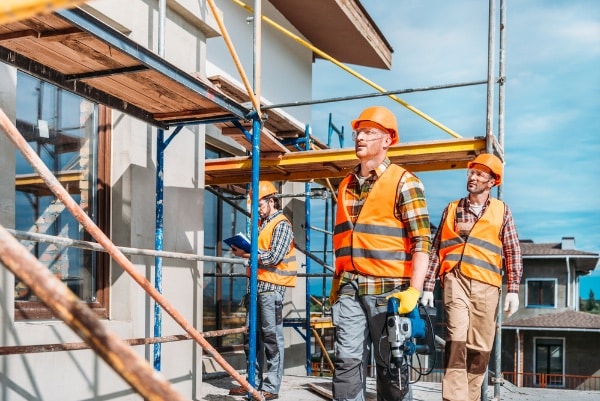
Establishing who may inspect the scaffolds on any worksite is an essential safety precaution.
OSHA states that a “competent person” is the only one who is authorized to inspect a scaffold.
OSHA standard §1926.450(b) defines a competent person as able to identify hazards (existing and foreseeable) in the work environment that endanger people and be authorized to take action to eliminate these risks. This information is also part of our Scaffold Safety Training program as well.
Let’s take a deeper look.
Why Scaffold Inspection Is Necessary
The nation sees over 4,000 scaffolding-related injuries yearly, including an average of 50 deaths. Scaffolding poses several hazards: employees could fall, falling objects can strike people below, or electrocutions can happen.
The scaffolding may even collapse, leading to catastrophic injury or death of workers on the scaffold and crush injuries to people beneath or nearby.
It is easy enough for scaffolding to collapse. Alterations during a shift can compromise the scaffold’s structural integrity, potentially leading to collapse.
High winds, unauthorized alteration, or contact with a vehicle can destabilize the structure, making it unsafe.
Overloading the scaffold beyond its maximum capacity will also lead to collapse. As OSHA standards provide a large safety margin, the so-called Law of 4, overloading should not happen!
Many scaffold-related injuries (around 7 in 10) are “minor,” with personnel being injured by slippery platforms, a plank that gives way, or a minor failure of the supports.
Nevertheless, such incidents still lose labor hours and can lead to worker compensation claims. And they are almost entirely preventable by regular inspection by a competent person.
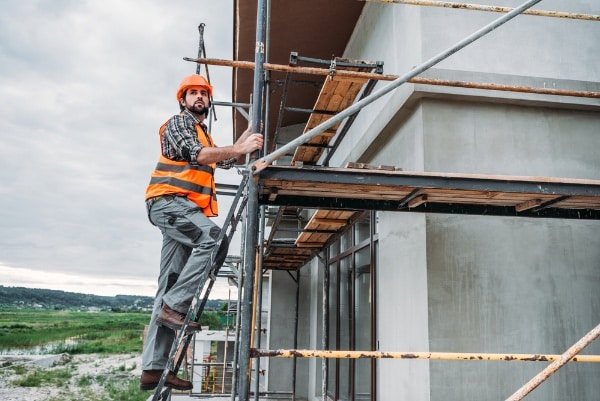
A Competent Person Has the Authority to Perform a Scaffold Inspection
The OSHA standard for scaffolding is §1926:451; it specifies safety precautions for all types of structures on the market. Employers should follow these when drafting protocols for scaffold use.
Does OSHA Require Scaffold Certification?
Only a competent person may inspect a scaffold to comply with OSHA standards. To be considered competent, this individual must be certified as having training that thoroughly covers scaffolding safety.
A competent person must not only have the training to identify dangers in the work environment, but they must also have the authorization to take prompt corrective action.
This competent person must track which scaffolds they have inspected and keep records; this is much easier in the cloud. Using a scaffold inspection checklist helps ensure that no details are missed.
All Workers Must Be Trained in Scaffold Safety Measures
Everyone performing work on or near a structure must receive training in scaffold safety measures. Specifically, they must complete a training course covering OSHA’s scaffolding standards.
Training must include:
- The dangers associated with scaffolding include electrical hazards, falls, and falling object injuries.
- The proper handling of a scaffold and tools and materials.
- The load-bearing capacity and the maximum intended load of the scaffold in question.
- The management and minimization of such hazards.
- Any other relevant requirements will depend mostly on your business’s scaffolding type. It will differ between construction companies and painters.

The Fundamentals of Scaffolding Safety
It’s all good to say a competent person must inspect the scaffolds. But what does that look like?
How Often Does a Scaffold Need to Be Checked for Safety?
OSHA insists that you inspect scaffolds daily. We recommend setting aside about 40 minutes (depending on how much scaffolding your company uses) to inspect all components thoroughly.
While regular inspections may seem like a waste of time, they allow you to identify potential dangers that can be minimized or eliminated, preserving the scaffold’s structure and keeping your people safe.
Scaffold inspections must happen before every work shift starts in areas where people will be laboring on, around, or near scaffolding.
Inspection must also happen after a shift if anything has happened during the shift that may have weakened the scaffold’s structural integrity.
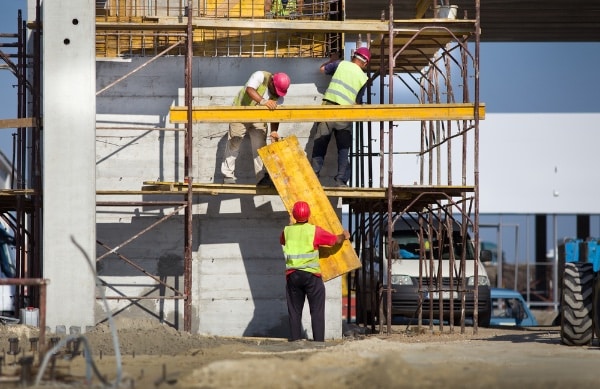
Communicate With Each Other
It’s essential to post OSHA-compliance signs advising employees that a particular scaffold is unfinished, hence dangerous, and should not be used. This does not do away with the need for inspections!
Tags are a valuable communication tool to ensure scaffold safety. A three-color system should be used: green tags indicate to staff that the scaffold has been inspected and is safe to use.
On the other hand, red tags are a clear “danger” signal: a scaffold with a red tag is still being built or a problem has been identified. Either way, workers know not to use it.
Yellow tags tell people a scaffold is safe to use, provided they observe specific requirements, such as wearing fall protection. You should also train your employees to understand when fall protection is necessary when working on scaffolding. (Answer, it’s always necessary).
Red and yellow tags also send a message to the competent person performing the inspection for the following shift: they can note the issue and determine if it still applies.
A Qualified Person Is Permitted to Build Scaffolding
Scaffolds must be designed and built by a qualified person and operated in line with that design. OSHA stipulates that a qualified person has the formal credentials and a record showing they can solve relevant problems.
OSHA stipulates that a qualified person possesses the required degree, certificate, or other training and experience to solve problems relating to a particular field of work, as demonstrated by their track record.
A competent person must supervise a scaffold’s construction, alteration, relocation, or disassembly.
OSHA holds that once the competent person has declared the scaffold safe to use, they are responsible that it remains appropriate for the job and safety for the rest of the work shift.
Copies of the specifications and drawings design engineers have created of the scaffolding must be available to employers and competent persons.
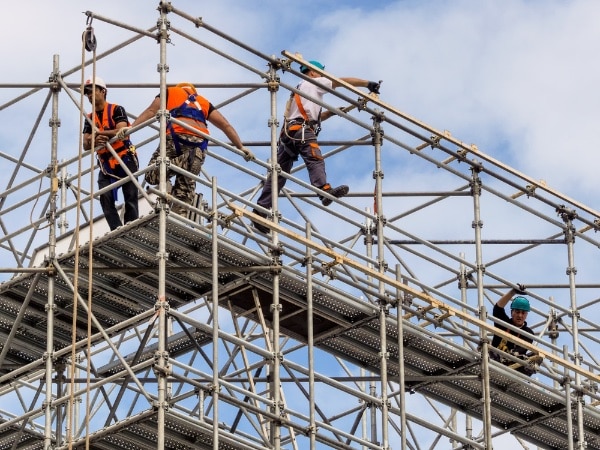
What Are the Responsibilities of Scaffolding Inspection?
Scaffolds and all scaffold components must be able to support their weight plus a minimum of 4 times the maximum load the member will be subject to without fail.
This is known as the Rule of 4.
The catastrophic consequences of scaffold failure for any people on it or in the vicinity are paramount for employers, and abiding by this rule is non-negotiable.
Inspection of the Work Environment
The competent person must evaluate the environment in which it will be used and call off work should weather conditions be unsafe.
The type of scaffolding must be evaluated to determine whether it’s appropriate for the load, the job, and the weather conditions.
A high wind poses a risk of the scaffold tipping over. An electric storm or proximity to energized power lines poses an electrocution danger if tools contact them. Scaffolds must be kept at least 10 feet away from power lines.
Snow, sleet, or heavy rain are dangerous, and the work shift should be called off. Such storms can leave mud, wet leaves, snow, or ice on access areas, ladders, and platform boards, posing a slipping hazard.
Inspectors should ensure adequate ventilation if the work shift is indoors, especially if the work process will release any potentially hazardous gases.
Check whether there are workers under the platform before the work shift begins. Barricade the area against entry.
Should it be necessary that people remain in this zone, they must receive falling object protection, in particular, hard hats.
How Do You Conduct a Scaffolding Inspection?
Scaffolds are made of many parts. Let’s look at the basic categories of scaffold components and how each should be assessed during an inspection.
The Foundations
Footings rest on the ground. They must be able to support the loaded scaffold. They must be level and resting on baseplates and mudsills to achieve this.
The footings must be level and of the required capacity to support the loaded scaffold. The mud sills and base plates must bear weight transmitted by the rest of the structural members.
The ground must also be inspected: it must not be uneven, soft, or crumbling so that the scaffold is undermined.
The Metal Components
A competent person must assess the metal components that make up the frame. They must check for defects such as:
- Rust
- Pits
- Holes
- Cracks
- Bends
- GMAW welding splatter
- Broken welds
Bent or kinked frames must be discarded.
They should also examine the couplings to ensure they are not damaged, loose, or not fitting correctly (often due to the wrong part being used).
An inspection must determine whether a scaffold has non-compatible parts from another manufacturer that people have stuck in to get the job done. These weaken the structure and make collapse more likely.

Platforms Are Built With Scaffold-Grade Lumber
All scaffolds must be built of planks made of scaffold-grade lumber. They should be close together, with spaces no greater than 1 inch around uprights.
Examine the boards for defects:
- Cracks or splits greater than 1/4-inch or long end splits.
- Large loose knots.
- Boards and ends showing gouges.
- Separated laminate.
- Grain sloping greater than 1 in 12 inches concerning the long end.
- Warps greater than 1/4-inch.
- Deflection of 1/60 of the span of a wooden plank, or 2 inches in 10 feet along the long edge.
Wooden planks 10 feet or shorter must lie 6 to 12 inches over the support’s center line, while long planks over 10 feet must jut no more than 18 inches beyond the end.
Remember: shorter planks are liable to slip; longer planks to tip.
A platform must be cleaned regularly and cleated to prevent slip or fall injuries.
Requirements for Rails
Platforms must have guardrails, which must be between 38 and 45 inches above the platform.
If cross bracing is functioning as a guardrail, it must meet the same requirements.
Midrails must be around halfway between the top rail and the platform. If cross bracing fulfills this function, it must be between 20 and 30 inches above the platform.
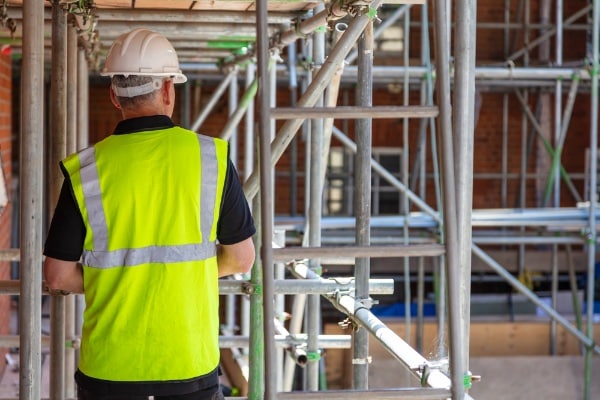
Safe Operation of a Scaffold
Scaffolds should be a maximum of 14 inches from the building or a maximum distance of 18 inches from the wall when applying plaster or stucco to a construction.
Tie-ins, guys, and bracing should be used at either end of the scaffold to prevent tipping. Working height must never be increased by using a ladder atop the scaffolding! Never move a scaffold if anyone is aloft.
The competent person must ensure no one uses the cross braces to access or exit the scaffolding; instead, staff should have safe access by a ladder, which should meet the code, not be damaged, and be long enough.
Scaffold Inspection Checklist
A scaffold inspection checklist is an essential tool for effectively inspecting scaffolds. Inspectors may feel that a checklist will limit them or that they already know their job.
However, anyone can make a mistake. A scaffold inspection checklist helps you avoid human error due to fatigue or other causes.
Whether you’re in home construction or installing electric turbines, you’ll find it useful.
Checklist records also protect you when something goes wrong: while any accident is tragic, preventable death is haunting and a terrible stain on a company’s record. It’s vital to demonstrate conclusively that the necessary precautions were taken.
Final Thoughts
To prevent disastrous accidents, scaffold inspection is vital to catch defects in structural components or any compromise to the structure’s integrity. Such inspections may only be done by a competent person. Hopefully, we have clarified exactly who is authorized to inspect a scaffold.